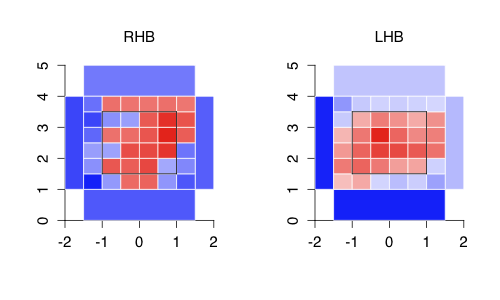
| F/X Visualizations | December 18, 2009 |
Last week I looked at the pitchers involved in the Winter Meetings's 'big trade,' and then this week an even bigger trade went down. The Blue Jays sent the Phillies Roy Halladay for a package of three prospects. The Phillies then turned around and sent Cliff Lee to the Mariners for slightly lesser group of three prospects. By now there has been extensive analysis of the trade, but the emerging consensus is: the Blue Jays needed to trade Halladay before he became a free agent after failing to do so last season; the Phillies took a slight hit to their farm system for an upgraded ace willing to sign a long-term deal rather than test the free agent waters; and the Mariners, looking to compete for the AL West title in 2010, picked up one of the game's best pitchers.
As I did last week, I am going to take a pitchf/x look at the major league pitchers in the deal. They are two of the best pitchers in baseball. Over the past two years they are two of just seven starters to post an ERA below three. They did so throwing 482 (Halladay) and 455 (Lee) innings, only CC Sabathia has thrown more over that period. They rank one and two in lowest BB/9 and one and three for the highest K/BB ratio over that period. Halladay adds the third leg to the stool, by also inducing over 50% GB per BIP, which makes him a little bit better than Lee. Still these are two of the best pitchers in the game. Additionally by limiting walks they are able to go deep in games, which helps their teams by reducing bullpen strain.
Roy Halladay
I have written two articles at FanGraphs looking at Halladay's pitchfx numbers. The first broke down his pitches to RHB and LHB. It showed that he has a very even pitch distribution, throwing one of three pitches -- two-seam fastball, cutter or curve -- often to both LHBs and RHBs.
+-------------------+------+------+ | | vRHB | vLHB | +-------------------+------+------+ | Two-Seam Fastball | 0.34 | 0.31 | | Cutter | 0.39 | 0.43 | | Curveball | 0.26 | 0.20 | | Changeup | 0.01 | 0.06 | +-------------------+------+------+
Batters cannot go up and expect one specific pitch over 60% of the time like they do with against some pitchers.
The second post showed that he uses his cutter and two-seam fastball to give him a pitch to go inside and outside against both LHBs and RHBs. His two-seam fastball used inside against RHBs and outside against LHBs, and his cutter is the opposite. This allows him to avoid the middle of the plate, while varying the location of his pitches -- inside and outside -- to both RHBs and LHBs.
This helps explain his strike outs and walks, but whence the grounders? The obvious place to look is pitch height. Here Halladay's pitches are in red and the average in gray.

His cutter is much lower in the zone than the average cutter, probably leading to his great groundball rate. His two-seam fastball is not that much lower than average, rather much more often in the zone, further reason for his low walk rate.
Cliff Lee
Over the past two years -- since Lee really emerged as a dominant pitcher -- no pitcher has a had a more successful fastball, which is a surprising fact. Part of this is that no one is better than Lee at getting his pitches, and his fastball particularly, in the zone.
To look at this in a spatially explicit manner I broke the strike zone and area around in into a number of bins. I calculated the frequency of Lee's fastballs in each bin and than compared that to the frequency for the average lefty's fastaball. Bins in which Lee had a higher frequency than the average lefty were red and a lower frequency blue. The intensity of the color indicates the size of the difference. As always the images are from the catcher's perspective, so RHBs stand at -2 and LHBs at 2.

Against RHBs Lee locations his pitches more up and away than average, and as a whole more in the zone and just out of the zone than average. This is as expected. Against LHBs the pattern is even more extreme. In every strike zone bin he has a higher frequency than average, and is much lower in the farthest away from the zone bins.
Overall it was another exciting week. The Blue Jays cashed in on Halladay and to continue their rebuilding process. The Phillies got one of the best pitchers in the game, whose grounders should play very well in their small park and locked him up for years. And the Mariners picked a great pitcher, who as a lefty mitigates opposing LHBs's advantage at Safeco, as they look to compete in 2010.
Comments
the one thing you cannot account for is post season success. (We cannot account for it because halladay has not pitched in the post season) (success is more like Dominimation in the case of Lee)
+++ Who do you want on your roster, Greg Maddox or Orel Hershiser? Yes this is 20/20 hindsight, but why trade Lee and his post season dominating performances for a possible Maddox-like post season pitcher in Roy H
Posted by: c smith at December 31, 2009 3:55 AM